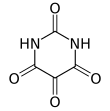四氧嘧啶
外观
| 四氧嘧啶[1] | |||
|---|---|---|---|
| |||
| IUPAC名 1,3-Diazinane-2,4,5,6-tetrone 1,3-二氮杂苯-2,4,5,6-四酮 | |||
| 别名 | 阿脲,阿洛占 Mesoxalylurea,5-Oxobarbituric acid | ||
| 识别 | |||
| CAS号 | 50-71-5 2244-11-3 2244-11-3 | ||
| PubChem | 5781 | ||
| ChemSpider | 5577 | ||
| SMILES |
| ||
| InChI |
| ||
| InChIKey | HIMXGTXNXJYFGB-UHFFFAOYAQ | ||
| ChEBI | 76451 | ||
| MeSH | Alloxan | ||
| 性质 | |||
| 化学式 | C4H2N2O4 | ||
| 摩尔质量 | 142.07 g/mol g·mol⁻¹ | ||
| 外观 | 固体 | ||
| 密度 | 1.639 g/cm^3 | ||
| 熔点 | 256 °C (分解) | ||
| 溶解性(水) | 混溶 | ||
| 危险性 | |||
| MSDS | MSDS | ||
| 若非注明,所有数据均出自标准状态(25 ℃,100 kPa)下。 | |||
四氧嘧啶(2,4,5,6-嘧啶四酮)是嘧啶的一种含氧衍生物。在水溶液中以水合物形式存在。
历史
[编辑]四氧嘧啶是最早被命名的有机化合物之一。它最早由意大利化学家Luigi V. Brugnatelli在1818年分离,但是由于Brugnatelli当年即去世,并没有能够对它做进一步研究。1838年德国化学家维勒和李比希再次发现它将其命名为Alloxan。Alloxan这个词由Allantoin(尿囊素)和Oxalsäure(草酸)合并而来。
合成
[编辑]最初的四氧嘧啶由硝酸氧化尿酸制得[2],也可由三氧化铬氧化巴比妥酸制得[3] 。
生物效应
[编辑]1943年,三名英国医学研究人员Dunn,Sheehan和McLetchie在lancet上发表论文,报道了用四氧嘧啶破坏胰岛细胞,进而导致动物实验性糖尿病。[4]
参考文献
[编辑]- ^ 默克索引,11版,281。
- ^ Holmgren, A. V. (1952). "Alloxan monohydrate". Org. Synth. 32: 6; Coll. Vol. 4: 23.
- ^ Tipson, R. S. Alloxantin dihydrate. Org. Synth. 1953, 33: 3 [2013-04-15]. (原始内容存档于2006-01-12).
- ^ Dunn, J. S.; Sheehan, H. L.; McLetchie, N. G. B. Necrosis of Islets of Langerhans Produced Experimentally. Lancet. 1943, 241 (6242): 484–487. doi:10.1016/S0140-6736(00)42072-6.
外部連結
[编辑]- McLetchie, N. G. Alloxan Diabetes, a Discovery, albeit a Minor one (PDF). The Journal of the Royal College of Physicians of Edinburgh. 2002, 32 (2): 134–142 [2013-04-15]. PMID 12434795. (原始内容存档 (PDF)于2013-04-18).
- The history and chemistry of the Murexide dye(页面存档备份,存于互联网档案馆)


